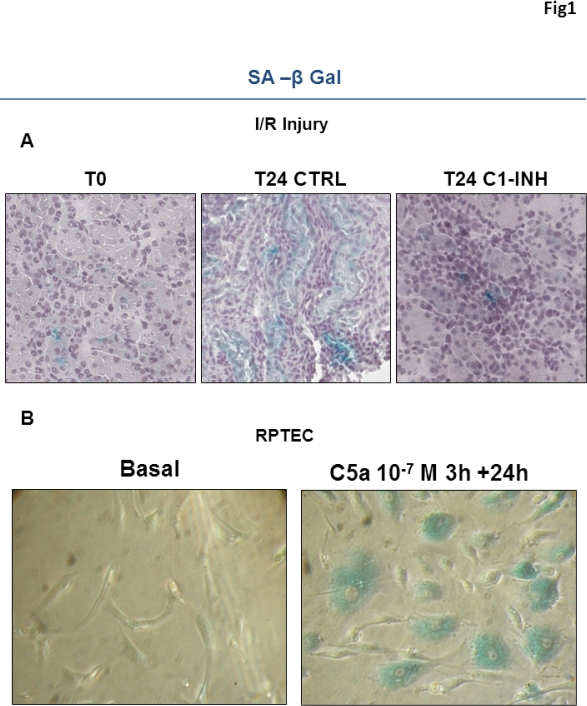C1-Inhibitor Abrogated Ischemia/Reperfusion (I/R) Induced Inflammaging by Inhibiting Senescence-Associated Secretory Phenotype (SASP) in Tubular Epithelial Cells (TEC).
1Department of Emergency and Organ Transplantation, University of Bari, Bari, Italy
2Pharming Technologies, Leiden, Netherlands
3Department of Medical and Surgical Sciences, University of Foggia, Foggia, Italy.
Meeting: 2016 American Transplant Congress
Abstract number: C133
Keywords: Age factors, Inflammation, Pig, Renal ischemia
Session Information
Session Name: Poster Session C: Ischemia Reperfusion Injury and Organ Preservation
Session Type: Poster Session
Date: Monday, June 13, 2016
Session Time: 6:00pm-7:00pm
 Presentation Time: 6:00pm-7:00pm
Presentation Time: 6:00pm-7:00pm
Location: Halls C&D
Inflammaging is a pathogenic process usually associated with chronic kidney disease such as diabetic nephropathy where TEC cells have a diminished regenerative potential and develop a chronic inflammatory state. We investigated whether inflammaging could occur in a swine model of (I/R) injury. After 30 min of warm ischemia and 24 h of reperfusion, IHC analysis demonstrated the occurrence of tubular senescence by the increase in nuclear p16INK4a expression and cytoplasmic SA-β Gal (T24 CTRL vs T0, p<0.05, Fig1A); in addition, TEC developed a pro-inflammatory state by significant IL-6 production (IHC), indicating the occurrence of SASP phenotype. Pigs treated by C1-INH (500U/Kg, 5 min before reperfusion) efficiently antagonized SASP in TEC by restoring p16INK4a, and IL-6 expression (Aperio IHC software, p<0.05) and SA-β Gal at basal level (T24 C1-INH vs T24 CTRL, p<0.05, Fig1A). Interestingly, short term exposure of TEC to C5a (3h) induced senescence in vitro by up-regulating SA-β Gal positivity both at 24h and 48h of culture (%SA-β Gal+ cells C5a 10-7 M 3h+24h : 13,5%±0.58 vs Basal 3.6%±0.8, Fig 1B). Western blot analysis showed significant NOX-4 expression in TEC, a NADPH oxidases acting as a source of reactive oxygen species (p<0.05), next to increased gene expression of IL-8, MCP-1 and TNFα. Finally, senescent TEC showed a significant increase in p53, as sign of cell cycle arrest. In conclusion, renal I/R can induce graft senescence by promoting the development of SASP in TEC. C1-INH might be a promising therapeutic approach to limit graft senescence thereby prolonging allograft survival. 
CITATION INFORMATION: Castellano G, Franzin R, Stasi A, Divella C, Gigante M, Simone S, Intini A, Picerno A, Pontrelli P, Crovace A, Battaglia M, Oortwijn B, Amersfoort E, Grandaliano G, Gesualdo L. C1-Inhibitor Abrogated Ischemia/Reperfusion (I/R) Induced Inflammaging by Inhibiting Senescence-Associated Secretory Phenotype (SASP) in Tubular Epithelial Cells (TEC). Am J Transplant. 2016;16 (suppl 3).
To cite this abstract in AMA style:
Castellano G, Franzin R, Stasi A, Divella C, Gigante M, Simone S, Intini A, Picerno A, Pontrelli P, Crovace A, Battaglia M, Oortwijn B, Amersfoort E, Grandaliano G, Gesualdo L. C1-Inhibitor Abrogated Ischemia/Reperfusion (I/R) Induced Inflammaging by Inhibiting Senescence-Associated Secretory Phenotype (SASP) in Tubular Epithelial Cells (TEC). [abstract]. Am J Transplant. 2016; 16 (suppl 3). https://atcmeetingabstracts.com/abstract/c1-inhibitor-abrogated-ischemiareperfusion-ir-induced-inflammaging-by-inhibiting-senescence-associated-secretory-phenotype-sasp-in-tubular-epithelial-cells-tec/. Accessed January 5, 2026.« Back to 2016 American Transplant Congress
